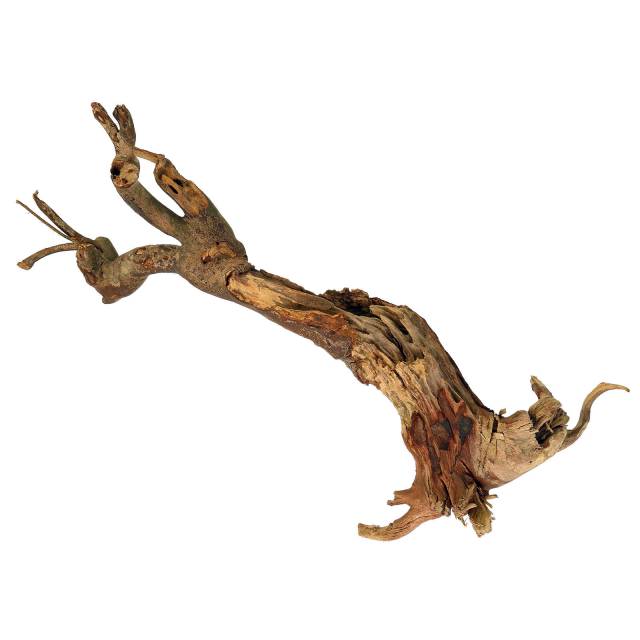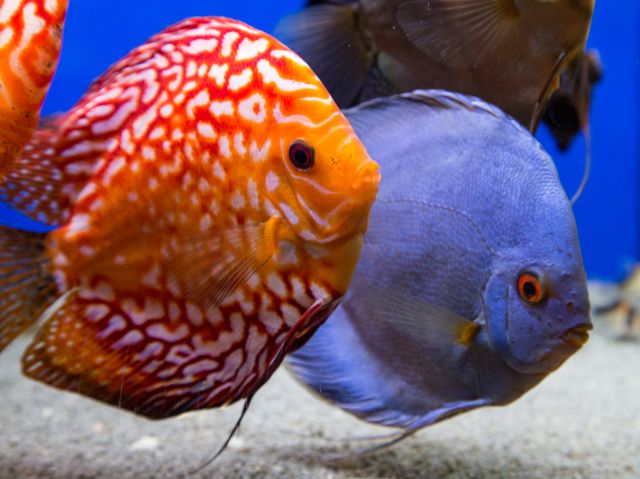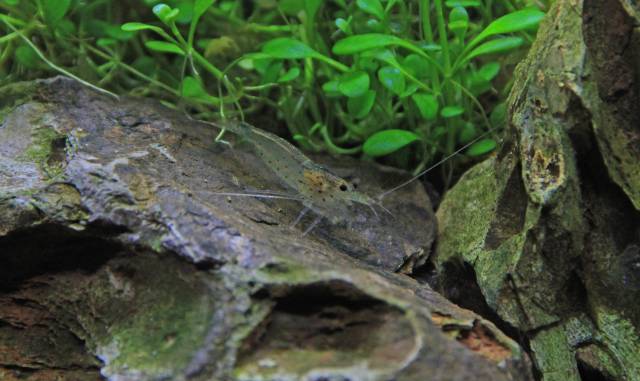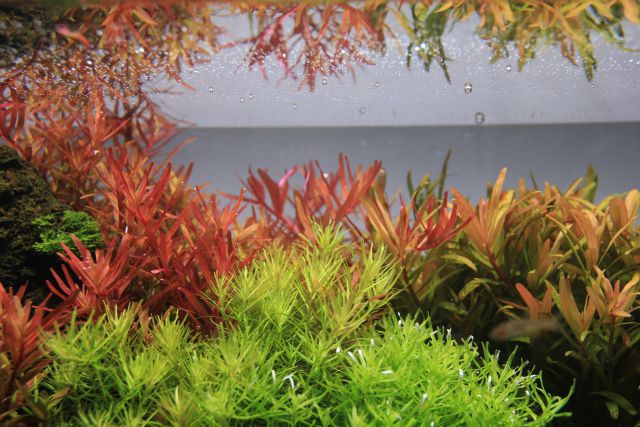Discus, popularly called the kings of the aquarium, are really particular animals, which stand out for their majestic grace and color. They belong to the family of cichlids, even though their unique, round shape isn’t exactly a dead giveaway. Their high-backed and compact physique is reminiscent of a discus or frisbee , which is what got them their nickname. The correct Latin name is Symphysodon. Discus fish are native to the Amazon region of South America, where temperatures are higher, especially in the larger water streams. Apart from some aquatic plants, mostly deadwood as well as tree branches and the roots of surrounding trees and bushes can be found in the waters of their natural habitats.

Keeping
Discus prefer low pH and soft water, just like most aquatic plants and other ornamental fish from South America. Discus are schooling fish and should be kept in groups of 5 animals upwards in a correspondingly large aquarium. As a rule of thumb you should plan with 50 to 80 liters per animal. Relevant literature states the ideal keeping temperature at a rather high 27 to 30°C. Instead of purchasing a high-power heater, it is a better idea to install two smaller heaters at the opposing ends of the tank, providing a better heat distribution and also the water temperature won’t sink too quickly should one of the heaters fail. The aquarium should be decorated with a lot of roots and driftwood, just as in their natural habitats. This will serve the fish as hiding spots and shelters and together with the aquatic plants they’ll ensure a well-structured design of the aquarium layout. As a substrate, fine sand is advisable at least in a couple of selected spots. While hunting for food, discus like to blow through the substrate in order to reach the microorganisms living inside. The lighting should initially not be too strong, because discus, especially those captured in the wild, are rather light-sensitive. The introduction of floating plants helps keeping light levels low. Domestically bred fish usually are already used to more intense lighting. With a little patience and long periods of adjustment, the lighting intensity can be gradually increased so that even more sophisticated aquatic plants can be kept.

Discus and planted aquariums
In fact, you have to make some compromises here and find a good middle ground to meet the demands of both the discus and plants. For this purpose, we will cover the relevant topics individually.
Temperature
Due to the higher keeping temperature, priority should be given to plants that can stomach this. Most plants in our shop have a rundown of their planting and cultivation conditions available in their profile, including their temperature tolerance. As a compromise between the keeping of fish and plants, a temperature of 28° can be realized pretty well. Higher temperatures close to 30° are too much for most plants, which drastically limits your choices.
CO2
Carbon fertilization is a bit of an issue when keeping discus, because they are pretty allergic to high CO2 levels. The recommended reference values of 20 to 30 mg/l CO2 should not be the top priority, but the health and well-being of the fish. Lower values of 15 to 20 mg/l are quite acceptable for sufficiently supplying your plants. In any case, the CO2 concentration needs to be monitored using a drop checker. A monitoring, by means of a pH-Controller is also useful.

Filtration
Another aspect in fusing a discus- with a planted aquarium is the overall filtration. While a certain "less-is-more" approach to filtration with only a few filter media has established itself for typical aquascapes with just a few or tiny inhabitants, a discus aquarium needs much more intense filtration. For the removal of suspended solids, you won’t be able to do without mechanical filtration, or a sufficient biological filtration, which takes care of breaking down the pollutants caused by the organic water load. This is necessary because discus fish eat quite a lot - and often - producing a corresponding amount of feces. This is due to their relatively short digestive tract. Discus fish are often fed several times a day, about two to three times. Younglings in the rearing, which still need to grow to maturity, might need food up to five times a day.
Lighting
If you want to keep more demanding plants, it is worth intensifying the aquarium lighting. To test if the lighting is sufficient, we recommend using the Flowgrow lighting calculator. In order to keep more demanding plants e.g. reddish stem plants, the lighting should be of the category “medium” to “high”. Discus from local breeders in particular can, with a bit of patience and understanding, get used to stronger lighting. Perfect for this are LED lighting systems, which can be continuously adjusted in brightness via a daylight simulator. This gently helps the fish getting used to higher lighting levels.
Substrate
While plant aquarists swear by the use of active soil substrates, fine sand is indubitably the first choice in a pure discus tank. Here too, a fusion of discus- and plant aquarium can come to a satisfying compromise by dividing the substrate into different zones. Soil is used for heavily planted areas and pure sand for zones in the foreground. The sand surfaces can then be used by the animals for food intake or as a feeding point. How to best separate the two substrates is explained in our article "sand and soil". Equipping the aquarium with just soil is feasible, if a few things are considered. Soil is a rather light substrate, so when the discus blow into it while hunting for food, the substrate might be swirled up and uproot ground cover. Here it is best to fall back to deep- or intense rooting ground cover like Cryptocoryne parva or Eleocharis parvula, which keep the substrate together. There is a lot of sludge and organic waste in a discus tank, thanks to the increased feeding. Coarser substrates such as gravel or soil can get compressed if neglected and there is a risk of rotting. A remedy can be a dedicated feeding spot, which may be a sand zone as mentioned above, that can be kept clean much easier. Alternatively feeding trays can be placed onto the substrate.
Algivores

Typical algivores like Amano- or Dwarf shrimp can only be kept in a discus tank with certain restrictions. Due to their small size, the invertebrates check out as “food” for the fish, so the shrimp should be big enough (like mature, female Amano shrimp, usually offered as XL shrimp in trade). Partly dwarf shrimp can be socialized with discus fish, provided there are enough hiding places for the shrimp. In addition, their number should be large enough, because certainly every now and then one can and will be eaten by the discus. Here, however, one can counteract the feeding pressure with a sufficiently large group strength and a corresponding propagation rate of the shrimp. In fact, invertebrates are - from a biological point of view - an enrichment for any discus tank as they further utilize their waste and faeces and thus improve the ecological balance.
Furthermore, snails such as Neritidae or Clithons, as well as Otocinclus catfish, are great for keeping all aquarium surfaces free from algic coats. This alleviates and facilitates the aquarist’s maintenance effort.
The increased feeding rate will worsen water pollution. This can be determined by increased concentrations of phosphate and nitrate. The fusion of a discus- with a plant aquarium has great advantages. The aquatic plants process nutrients such as nitrate and phosphate and help keeping organic water pollution low. In addition, a lushly planted aquarium offer significantly more colonization surface for sessile bacteria, which are useful in the degradation of pollutants in respect to the nitrogen cycle.

Although you’ll have to compromise when setting up a plant aquarium with discus fish inhabitants, it is still possible to get excellent results. The aquarist is rewarded with a beautifully designed underwater world, where the animals can draw their majestic circles.